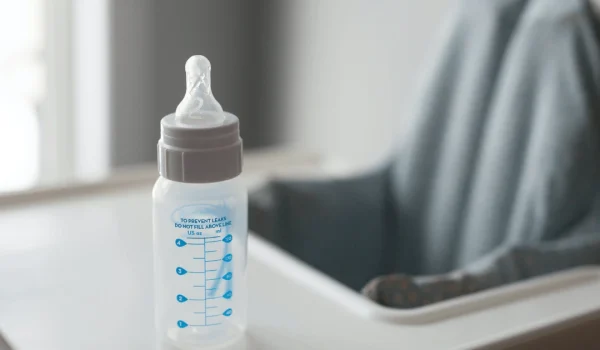Frequently Asked Questions About the Best Baby Bottles
Explore this comprehensive list of frequently asked questions (FAQs) about the best baby bottles. We want to help parents and caregivers make informed choices about feeding their little ones.”From choosing the right bottle to addressing common concerns, we’ve got your baby bottle questions covered”.
Consider factors such as material, size, shape, and ease of cleaning.
Yes, many parents prefer glass bottles as they are free from harmful chemicals.
Most modern baby bottles are BPA-free, but it’s important to check the label.
Wide-necked bottles are easy to clean and mimic the shape of the breast.
They can help, but results vary from one child to another.
Some bottles are compatible with storage bags for added convenience.
Many parents find that silicone or glass bottles work well for this transition.
Find slow, medium, and fast flow options based on your baby’s age and feeding needs.
Yes, twin feeding bottles are available with simultaneous feeding features.
Yes, many brands offer eco-friendly options, such as glass or recycled plastic bottles.
Wash bottles in hot, soapy water and sterilize by boiling, using a microwave sterilizer, or bottle sterilizer.
This is not recommended as it may create hotspots. Use a bottle warmer instead.
Use bottles designed for storing breast milk and follow guidelines for safe storage.
It is best to use spoons or other eating utensils for solid foods.
Yes, some bottles have liners that can be discarded after each use.
Smaller sizes, such as 4-5 ounces, are suitable for infants, as they have smaller appetites.
Latex is softer but can wear out quickly, while silicone is stronger and more durable.
Yes, some bottles have angled or vented designs to reduce air intake and reduce reflux symptoms.
Yes, wide neck bottles are more accessible for cleaning and filling.
Choose bottles that mimic the shape of the breast and use a slow-flow nipple.
Yes, you can use baby bottles for water, juice, or other age-appropriate liquids.
Shaking, difficulty, or excessive air consumption may indicate a need for replacement.
Most brands offer additional parts and accessories for your convenience.
Consider heating a portable bottle or placing the bottle in warm water.
Yes, some bottles have compartments for pre-measured formula.
It depends on the contents of the bottle and the manufacturer’s recommendations.
Yes, the purpose of angled or aerated bottles is to reduce air intake during feeding.
Yes, you can find bottles in a range of colors and designs to suit your preferences.
Baby bottles can be used for younger babies, but transferring to a sippy cup is recommended.
Some bottles come with self-sterilizing options, which can be convenient.
Allow them to air dry before storing them in a tidy, dry location.
You can find both individual bottles and sets to suit your needs.
Reusable bottles can be cleaned and used many times, while disposable bottles are for one time use.
Yes, most bottles are versatile and can be used for different types of milk.
Look for bottles with venting systems that reduce air intake during feeding.
Bottles with breast-like shapes and slow-flow nipples can make transitions easier.
Yes, bottle brushes and sanitizers can help ensure bottles are clean and safe.
Although it is possible, older children usually transition to a sippy cup.
Symptoms include frustration during feeding and the need for a fast-flowing nipple.
Look for bottles with advanced anti-colic properties designed to reduce the amount of wind.
Bottles with wide nipples are suitable for thick liquids such as cereal.
Ensure a good latch, mimic the shape of the breast, and make breastfeeding more pacing.
Yes, many bottles have measurement markings for easy formula preparation.
Bottles with built-in venting systems can help reduce pressure differences during travel.
Introduce the bottle gradually, choose a time when your baby is not too hungry, and be patient with the transition.
Some bottles are dishwasher safe, but a dedicated sanitizer may be more effective.
Yes, you can choose between latex and silicone nipples based on your baby’s preference.
Yes, many bottles are suitable for storing pumped breast milk in the fridge or freezer.
Introduce sippy cups gradually and reduce bottle feedings over time to ease the transition.
Some bottles have temperature indicators that change color when the liquid is too hot.
Yes, baby bottles can be used for special feeding if needed.
Some bottles have fewer parts and are designed for easy cleaning.
Consult a healthcare professional and look for bottles designed for preemies.
Common shapes include standard, broad and breast-like. The choice depends on your child’s preference.
Yes, some bottles have disposable liners, which make cleaning a breeze.
Choose bottles that closely mimic the breast, especially in shape and flow.
Bottles with venting systems are intended to reduce pain symptoms, but results may vary.
Use a bottle warmer or place the bottle in a bowl of hot water.
Yes, some bottles have super soft nipples that are designed for a more natural feel.
Yes, but follow the specific mixing instructions on the formula packaging.



3 thoughts on “60 Frequently Asked Questions About the Best Baby Bottles”
Way cool, some valid points! I appreciate you making this article available, the rest of the site is also high quality. Have a fun.
Great article! I appreciate the clear and insightful perspective you’ve shared. It’s fascinating to see how this topic is developing. For those interested in diving deeper, I found an excellent resource that expands on these ideas: check it out here. Looking forward to hearing others’ thoughts and continuing the discussion!
Great read with a touch of humor! For further details, check out: READ MORE. What are your thoughts?